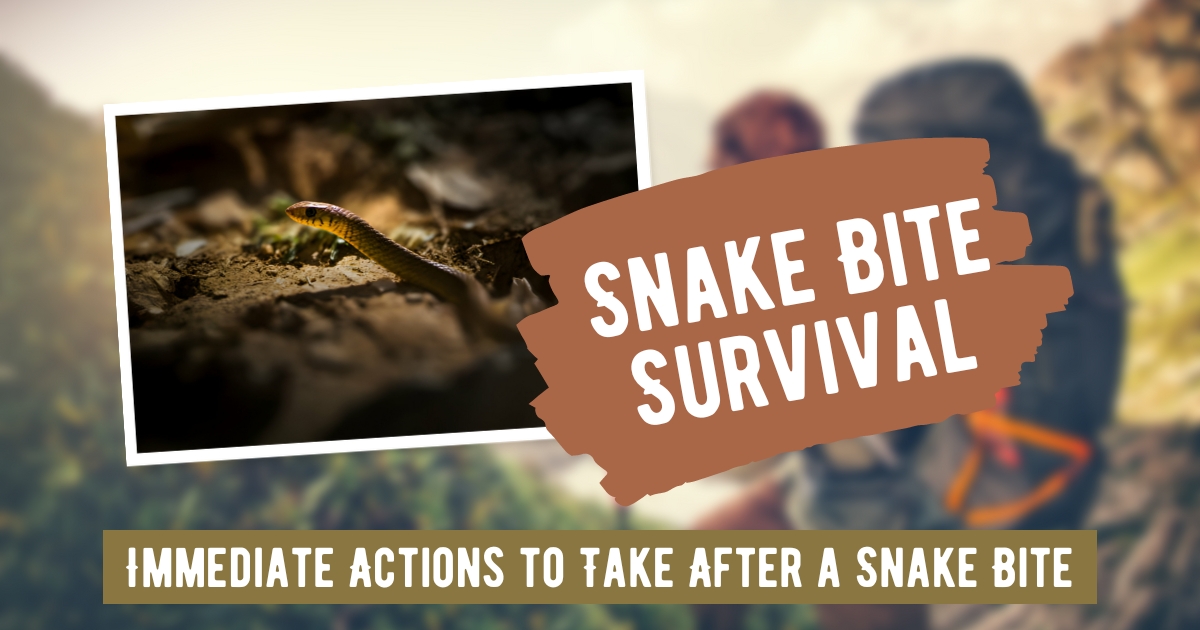Introduction
Snake bites, although relatively rare, can be life-threatening if not treated promptly and correctly. Whether you’re hiking in the wilderness, gardening in your backyard, or exploring new terrains, knowing the immediate actions to take after a snake bite can significantly impact the outcome. This article will guide you through the crucial steps you should take after being bitten by a snake, offering practical advice and tips to improve your chances of recovery. We’ll also highlight essential products that can aid in snake bite first aid, promoting safety and preparedness, such as a snake bite kit.
Explore Our Recommended Snake Bite First Aid Kits
Understanding the Severity of Snake Bites
1. Venomous vs. Non-Venomous Bites:
Venomous Bites: Bites from venomous snakes can inject toxins that affect your nervous system, blood, and tissues. Immediate action is critical to prevent severe health complications, including paralysis, organ damage, or death.
Non-Venomous Bites: These bites, while less dangerous, can still cause infection and require proper cleaning and care. However, it’s always safer to assume that a bite might be venomous until confirmed otherwise by a medical professional.
2. Identifying Venomous Snakes:
Common venomous snakes include rattlesnakes, copperheads, cottonmouths, and coral snakes in North America, among others globally. Look for distinguishing features like the shape of the head, presence of fangs, and color patterns, but avoid getting too close for identification.
Immediate Actions to Take After a Snake Bite
Stay Calm and Avoid Panic:
Why It Matters: Panic increases your heart rate, causing the venom to spread more rapidly throughout your body. Staying calm helps slow down the venom’s progression.
What to Do: Take deep breaths and focus on remaining as still as possible. Reassure yourself or others that help is on the way.
Call for Emergency Medical Assistance Immediately:
Contact Emergency Services: Dial your local emergency number (e.g., 911 in the U.S.) as soon as possible. Provide clear information about your location, the type of snake (if known), and the condition of the victim.
Stay on the Line: Follow any instructions given by the operator. If you’re in a remote area, have a satellite phone or emergency communication device handy for faster contact.
Keep the Affected Limb Immobilized and Lower Than the Heart:
Why It Matters: Keeping the bitten limb still and below heart level reduces the spread of venom by limiting blood flow to the area.
How to Do It: Use a splint or any rigid object to immobilize the limb gently. Avoid tight bandages or tourniquets, as they can restrict blood flow and worsen tissue damage.
Remove Tight Clothing and Jewelry Near the Bite Area:
Why It Matters: Swelling is a common reaction to snake bites. Removing items like rings, bracelets, or tight clothing can prevent them from becoming constrictive as swelling progresses.
What to Do: Gently take off any restrictive items around the bite area without disturbing the wound.
Clean the Wound Lightly, But Don’t Apply Ice or Suck Out the Venom:
What to Avoid: Contrary to popular belief, cutting the wound, sucking out the venom, or applying ice can cause more harm than good. These actions can increase the risk of infection and tissue damage.
How to Clean: Lightly wash the bite area with soap and water to reduce the risk of infection. Avoid rubbing or scrubbing, which could worsen the injury.
Do Not Consume Food, Drinks, or Medications Unless Advised by a Professional:
Why It Matters: Consuming alcohol, caffeine, or certain medications can exacerbate the effects of the venom. It’s best to avoid eating or drinking until a healthcare provider gives you specific instructions.
Monitor the Victim’s Condition:
Signs to Watch For: Symptoms of envenomation can include swelling, intense pain, nausea, dizziness, difficulty breathing, and changes in consciousness. Monitor these symptoms and report them to emergency responders.
Stay Prepared: Keep the victim as comfortable as possible while waiting for medical help. If breathing difficulties or severe symptoms develop, be ready to provide basic first aid, such as CPR if trained.
Products That Can Help in Snake Bite Situations
Snake Bite Kit:
What They Do: Snake bite kits, such as the Zoonimal Rattlesnake Venom Extractor, often include suction devices and other tools designed to help with first aid. While their effectiveness in venom extraction is debated, they can be valuable for wound care.
Rattle Snake Kit:
Purpose: Rattlesnake kits include tools designed to assist in first aid following a snake bite. It is important to carry a reliable kit when in areas known to have venomous snakes, such as rattlesnakes.
Venom Extractor:
What to Look For: Venom extractors can help in emergency situations where snake venom has been injected. However, it’s important to follow professional medical advice when using these tools.
The Importance of Being Prepared
Educate Yourself on Local Snake Species:
Knowing which snakes inhabit your area and their venom potential can better prepare you for encounters. Understanding the behavior and appearance of local snakes can be lifesaving.
Always Carry a Snake Bite Kit and First Aid Supplies:
Especially when venturing into snake-prone areas, carrying appropriate first aid supplies is essential. Snake bite kits, such as the Zoonimal Rattlesnake Venom Extractor, splints, and antiseptic wipes are some of the items you should always have on hand.
Wear Protective Clothing:
Snake-resistant boots, gaiters, and gloves can provide an extra layer of protection, reducing the likelihood of a bite reaching your skin.
Conclusion
The immediate actions you take following a snake bite can significantly impact the outcome of the situation. By staying calm, seeking medical help promptly, and following the correct first aid steps, you can improve your chances of a positive recovery. Equipping yourself with the right products, such as snake bite kits, rattle snake kits, and venom extractors, ensures you are prepared for any snake encounter. Prioritize safety, education, and preparedness to minimize risks and enjoy your outdoor adventures with confidence. For more information on essential first aid gear and snake-resistant clothing, visit our recommended products section.

Leave a Reply